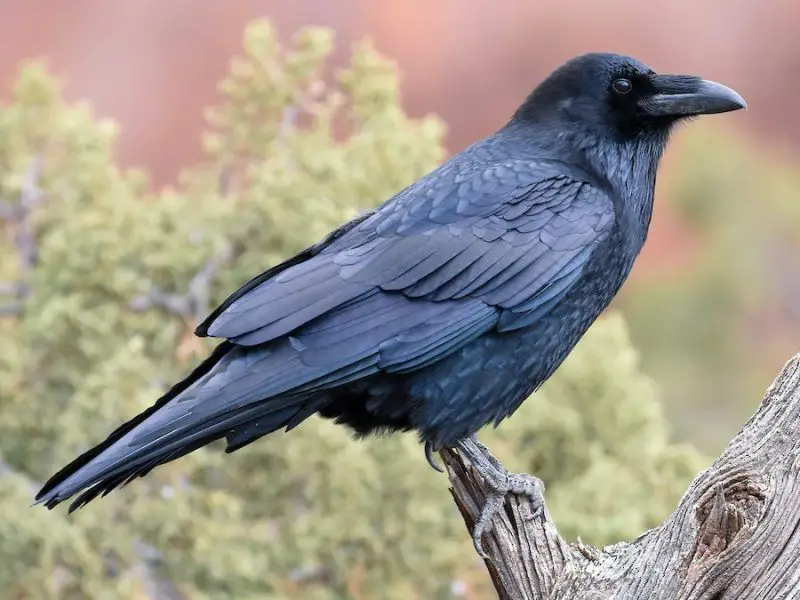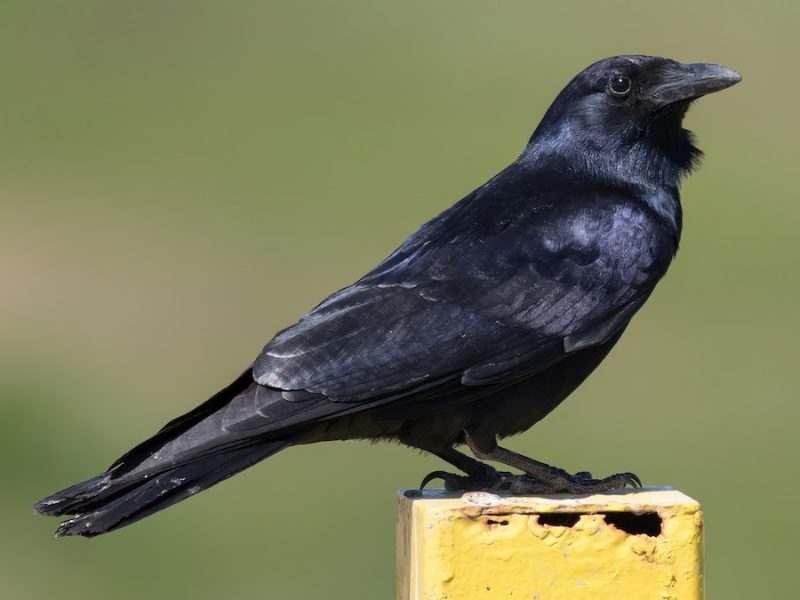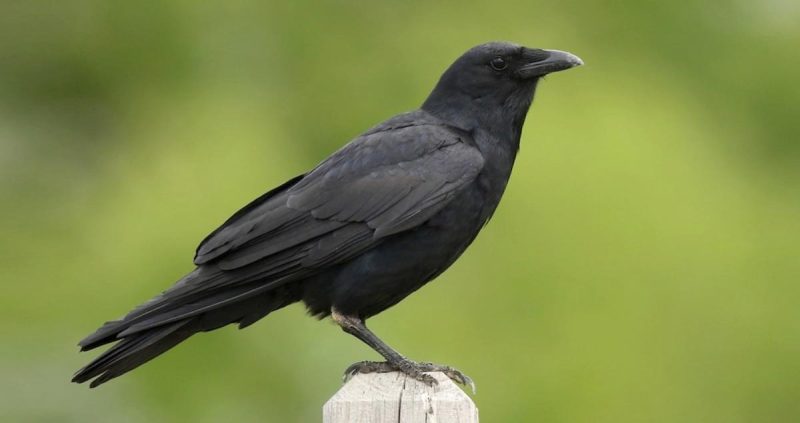Texas is home to a fascinating variety of bird species, including some of the most intriguing members of the crow family — ravens. When exploring the Types of Ravens in Texas, two species stand out as the most common and recognizable: the Common Raven (Corvus corax) and the Chihuahuan Raven (Corvus cryptoleucus). These birds are often spotted across various habitats throughout the state.
In addition to these true ravens, Texas is also inhabited by closely related species that are often mistaken for ravens. The Tamaulipas Crow (Corvus imparatus) and Fish Crow (Corvus ossifragus) share many similarities with ravens in appearance and behavior, making them important parts of the state’s avian diversity even though they are technically not ravens.
This article introduces the 4 main Types of Ravens in Texas, complete with clear pictures and identification tips for each species. This guide provides valuable information to help birdwatchers and nature enthusiasts recognize and appreciate these remarkable birds that play a vital role in Texas’s ecosystems.
Different Types of Ravens Found in Texas
Common Raven (Corvus corax)

The Common Raven is the largest of the raven species found in Texas, measuring between 24 and 27 inches (61 to 69 cm) in length, with an impressive wingspan ranging from 46 to 56 inches (117 to 142 cm). This size difference easily distinguishes it from crows and other smaller corvids. The bird’s plumage is a glossy, deep black with subtle iridescence that often reflects blue or purple hues in the sunlight. One of its most distinctive features is the wedge-shaped tail, visible when in flight, along with its large, thick, and slightly curved bill. The shaggy throat feathers or “hackles” are another unique characteristic that help birdwatchers identify the Common Raven.
In terms of behavior, Common Ravens are known for their intelligence and problem-solving abilities, often using tools and engaging in playful activities such as aerial acrobatics and sliding down snowy slopes. They are typically solitary or found in pairs, although young birds may gather in small groups before dispersing. Ravens communicate using a variety of harsh, croaking calls that are deeper and more resonant than those of crows. They are highly territorial, especially during the breeding season, and they often nest on cliff ledges, rocky outcrops, or tall trees in remote areas.
Common Ravens are opportunistic feeders with a very diverse diet. They eat carrion, small mammals, insects, grains, fruits, and even human food waste when available. Their ability to exploit a wide range of food sources allows them to thrive in the rugged, often harsh environments of Texas. In this state, they are mostly found in the western regions, especially the Trans-Pecos area and the Edwards Plateau, where rocky cliffs and mountainous terrain provide ideal nesting sites and safety from predators.
The distribution of the Common Raven in Texas is largely concentrated in these arid and semi-arid landscapes, where fewer competitors and predators exist. While sightings can occasionally occur in other parts of the state, the western and southwestern regions remain their primary habitat. This species adapts well to the varying conditions of Texas, from high desert to mountainous woodlands, making it one of the most resilient and widespread ravens in North America.
Chihuahuan Raven (Corvus cryptoleucus)

The Chihuahuan Raven is a medium-sized raven species, measuring between 21 and 27 inches (53 to 68 cm) in length, with a wingspan around 45 to 46 inches (115 to 117 cm). It resembles the Common Raven in many ways but is generally smaller and slimmer, with a less pronounced wedge-shaped tail. The plumage is uniformly glossy black, and the feathers have a sleek, smooth appearance without the shaggy throat hackles seen in Common Ravens. Birdwatchers often note its thinner bill and more streamlined body shape as key identification features.
In Texas, the Chihuahuan Raven prefers dry, open habitats such as arid grasslands, desert scrub, and agricultural fields. It is especially common in the High Plains and Trans-Pecos regions, where open terrain provides ample foraging opportunities. Unlike the more solitary Common Raven, Chihuahuan Ravens are known for their sociable behavior, frequently seen in pairs or small groups. In the winter months, larger flocks may form as birds gather in areas where food is abundant, providing safety and increased foraging efficiency.
The diet of the Chihuahuan Raven is highly varied, reflecting its opportunistic feeding habits. It consumes insects, small reptiles, seeds, grains, and carrion, often adapting to available food sources in agricultural areas. The species has been known to scavenge around farms and human settlements, feeding on leftover crops or discarded food. Its adaptability in diet and habitat allows it to thrive in environments where water is scarce, and temperatures can be extreme.
The range of the Chihuahuan Raven within Texas is primarily focused on the western and southern parts of the state, overlapping somewhat with the Common Raven but favoring more open and less rugged landscapes. Its presence in agricultural zones also distinguishes it from the more wild Common Raven, making the Chihuahuan Raven a familiar sight in many rural parts of Texas.
Tamaulipas Crow (Corvus imparatus)

The Tamaulipas Crow is a smaller member of the corvid family, measuring approximately 13.4 inches (34 cm) in length. Although not a true raven, it shares some physical similarities such as its glossy dark plumage, which has a bluish-black sheen under sunlight. This species is sleeker and more slender than the ravens, with a noticeably thinner and more delicate bill. The Tamaulipas Crow’s size and slim body help birdwatchers distinguish it from larger raven species, though it can be easily confused with other crow species at first glance.
Geographically, the Tamaulipas Crow is found mainly in northeastern Mexico but also extends into the southern tip of Texas, where its range overlaps with the Chihuahuan Raven. Its preferred habitats include subtropical scrublands, semi-arid thorn forests, and sometimes urban areas. The crow is often seen in small groups or family units, exhibiting social behavior similar to that of many crow species. In Texas, it tends to occupy areas with dense brush and scattered trees, offering shelter and nesting sites.
Behaviorally, the Tamaulipas Crow is known for its adaptability and opportunism. It feeds on insects, fruits, seeds, and small invertebrates, adjusting its diet seasonally and depending on local food availability. The crow’s vocalizations are varied but typically include a series of harsh and clear calls distinct from those of ravens. This species is less aggressive than ravens and tends to avoid human interaction when possible.
Though it is not classified as a true raven, the Tamaulipas Crow’s overlapping range and somewhat similar appearance have led to occasional confusion among bird enthusiasts. Understanding these differences is important for accurate identification and appreciation of Texas’s rich avian biodiversity. The Tamaulipas Crow contributes to the ecological balance in its habitat by controlling insect populations and dispersing seeds.
Fish Crow (Corvus ossifragus)

The Fish Crow is another close relative of ravens but is technically a crow species. It is slightly smaller than the American Crow and is distinguishable by its smaller, more delicate bill and unique vocalizations. Its plumage is glossy black with a slight iridescence, but its overall size and structure make it appear more compact and less robust than true ravens. The Fish Crow’s calls are higher-pitched and nasal, differing notably from the deep croaks of the Common Raven.
In Texas, Fish Crows are mostly found in coastal areas and along major rivers in the northeastern part of the state. Their habitats include marshes, estuaries, riverine woodlands, and other wetland environments where they have access to abundant aquatic food sources. Unlike the land-based Common and Chihuahuan Ravens, Fish Crows are closely tied to water and often forage along shorelines or in tidal zones.
Diet-wise, Fish Crows primarily feed on fish and other small aquatic animals but also consume insects, crustaceans, eggs, and carrion. Their opportunistic feeding habits allow them to thrive in coastal environments where food availability can fluctuate seasonally. These crows are often seen in groups, especially near fishing docks or areas where humans discard fish scraps.
Although the Fish Crow shares several similarities with ravens, such as its black coloration and intelligence, it is a distinct species adapted for life in aquatic habitats. Its presence in Texas adds to the diverse community of corvids in the state and highlights the different ecological niches that similar species can occupy.






